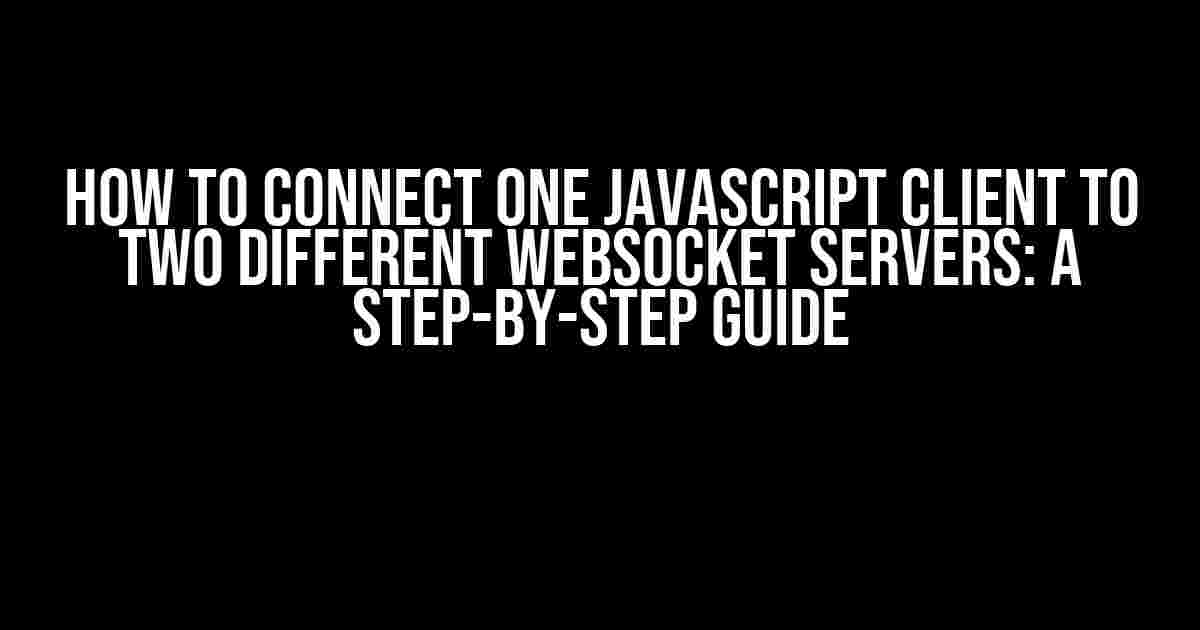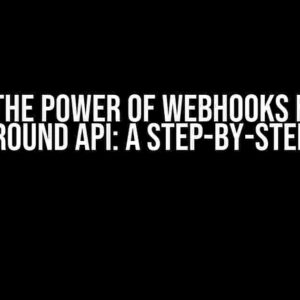Are you tired of being limited to connecting your JavaScript client to just one WebSocket server? Do you wish you could connect to multiple servers and unlock a world of possibilities? Look no further! In this article, we’ll take you on a journey to connect one JavaScript client to two different WebSocket servers. Buckle up, folks, and let’s dive in!
What Are WebSocket Servers?
Before we dive into the nitty-gritty, let’s quickly cover what WebSocket servers are. WebSocket is a protocol that enables bidirectional, real-time communication between a client and a server over the web. It’s like having a direct hotline to your server, allowing for efficient, low-latency communication.
WebSocket servers are the ones that handle these WebSocket connections, allowing clients to send and receive data in real-time. They’re commonly used in applications that require live updates, such as live scores, chat apps, and online gaming.
The Challenge: Connecting to Multiple WebSocket Servers
So, why is connecting to multiple WebSocket servers a challenge? The limitation lies in the fact that the WebSocket API is designed to connect to a single server. When you create a WebSocket object, you specify a single URL, which connects your client to that specific server.
But, what if you want to connect to multiple servers? You can’t simply create multiple WebSocket objects with different URLs, as that would create separate connections, and you wouldn’t be able to communicate between them.
The Solution: Using Multiple WebSocket Connections
The solution lies in creating multiple WebSocket connections, each connecting to a different server. Yes, you read that right – multiple connections! To achieve this, we’ll use a clever trick involving two WebSocket objects, each with its own connection.
Step 1: Create Two WebSocket Objects
First, create two WebSocket objects, each with its own URL pointing to a different server. We’ll use the `ws` library for this example.
const socket1 = new WebSocket('ws://server1.com/ws');
const socket2 = new WebSocket('ws://server2.com/ws');Note that we’re creating two separate WebSocket objects, each with its own connection.
Step 2: Handle Connection Events
Next, we need to handle the connection events for each WebSocket object. This involves adding event listeners for the `open`, `message`, `error`, and `close` events.
socket1.addEventListener('open', () => {
console.log('Connected to Server 1!');
});
socket1.addEventListener('message', (event) => {
console.log(`Received message from Server 1: ${event.data}`);
});
socket1.addEventListener('error', (event) => {
console.log(`Error occurred on Server 1: ${event}`);
});
socket1.addEventListener('close', () => {
console.log('Connection to Server 1 closed');
});
// Repeat the same for socket2
socket2.addEventListener('open', () => {
console.log('Connected to Server 2!');
});
socket2.addEventListener('message', (event) => {
console.log(`Received message from Server 2: ${event.data}`);
});
socket2.addEventListener('error', (event) => {
console.log(`Error occurred on Server 2: ${event}`);
});
socket2.addEventListener('close', () => {
console.log('Connection to Server 2 closed');
});By adding these event listeners, we’re preparing our WebSocket objects to handle incoming messages and events from each server.
Step 3: Send Messages to Multiple Servers
Now that we have our WebSocket objects set up, let’s send messages to both servers. We’ll use the `send()` method to send a message to each server.
socket1.send('Hello, Server 1!');
socket2.send('Hello, Server 2!');This will send a message to each server, and we’ll receive a response from each server, which we’ll handle in the `message` event listeners.
Step 4: Handle Messages from Multiple Servers
In the `message` event listeners, we’ll handle the incoming messages from each server. We can then use this data to update our application, display live updates, or perform any other action necessary.
socket1.addEventListener('message', (event) => {
console.log(`Received message from Server 1: ${event.data}`);
// Update our application with the received data
updateApplication(event.data);
});
socket2.addEventListener('message', (event) => {
console.log(`Received message from Server 2: ${event.data}`);
// Update our application with the received data
updateApplication(event.data);
});In this example, we’re simply logging the received message to the console, but in a real-world application, you’d want to handle the data accordingly.
Common Pitfalls and Considerations
Now that we’ve connected our JavaScript client to two different WebSocket servers, let’s discuss some common pitfalls and considerations.
Pitfall 1: Connection Limits
Be aware that most browsers and WebSocket implementations have connection limits. This means you can only establish a limited number of WebSocket connections to different servers. Be sure to check your browser’s documentation for specific limits.
Pitfall 2: Message Overhead
With multiple WebSocket connections, you’ll be sending and receiving more messages, which can lead to increased overhead. Be mindful of message size, frequency, and optimization techniques to minimize this impact.
Pitfall 3: Server Overload
Connecting to multiple WebSocket servers can lead to increased load on your servers. Ensure your servers are designed to handle the increased traffic and implement load balancing, caching, and other optimization techniques as necessary.
Conclusion
And there you have it – a step-by-step guide to connecting one JavaScript client to two different WebSocket servers! By creating multiple WebSocket connections, handling connection events, and sending and receiving messages, you can unlock a world of possibilities in real-time communication.
Remember to be mindful of connection limits, message overhead, and server load, and you’ll be well on your way to building scalable, high-performance WebSocket applications.
| Server | WebSocket URL |
|---|---|
| Server 1 | ws://server1.com/ws |
| Server 2 | ws://server2.com/ws |
- WebSocket API: https://developer.mozilla.org/en-US/docs/Web/API/WebSockets_API
- ws library: https://github.com/websockets/ws
We hope you found this article informative and helpful. If you have any questions or need further clarification, please don’t hesitate to ask in the comments below!
Happy coding, and may the WebSocket force be with you!
Here are 5 Questions and Answers about “How to connect one JavaScript client to two different WebSocket servers?” :
Frequently Asked Question
Get the answers to all your WebSocket woes!
Q1: Can I connect to multiple WebSocket servers from a single JavaScript client?
Yes, you can! In fact, it’s quite common to connect to multiple WebSocket servers from a single client. You can establish multiple WebSocket connections, each connecting to a different server, and manage them independently.
Q2: How do I create multiple WebSocket connections in JavaScript?
To create multiple WebSocket connections, simply create multiple instances of the WebSocket object, each with a different server URL. For example, you can create two WebSocket objects: `ws1 = new WebSocket(‘ws://server1.com’);` and `ws2 = new WebSocket(‘ws://server2.com’);`. Each object will establish a separate connection to its respective server.
Q3: How do I manage multiple WebSocket connections in a single JavaScript client?
To manage multiple connections, you can use a single JavaScript file to establish and manage all the connections. You can create an array to store all the WebSocket objects and then use a loop to send and receive data for each connection. You can also use separate functions or objects to handle the logic for each connection.
Q4: Are there any limitations to connecting to multiple WebSocket servers?
While connecting to multiple WebSocket servers is possible, there are some limitations to consider. For example, each connection will consume system resources, such as memory and CPU. Additionally, managing multiple connections can become complex, especially if you need to handle errors, reconnects, and message handling for each connection.
Q5: Are there any libraries or frameworks that can help me connect to multiple WebSocket servers?
Yes, there are several libraries and frameworks that can help you connect to multiple WebSocket servers. For example, Socket.IO is a popular JavaScript library that provides a simple API for establishing and managing WebSocket connections. Other libraries, such as ws and WebSocket-Node, also provide support for multiple connections.
I hope this helps! Let me know if you have any further questions.





